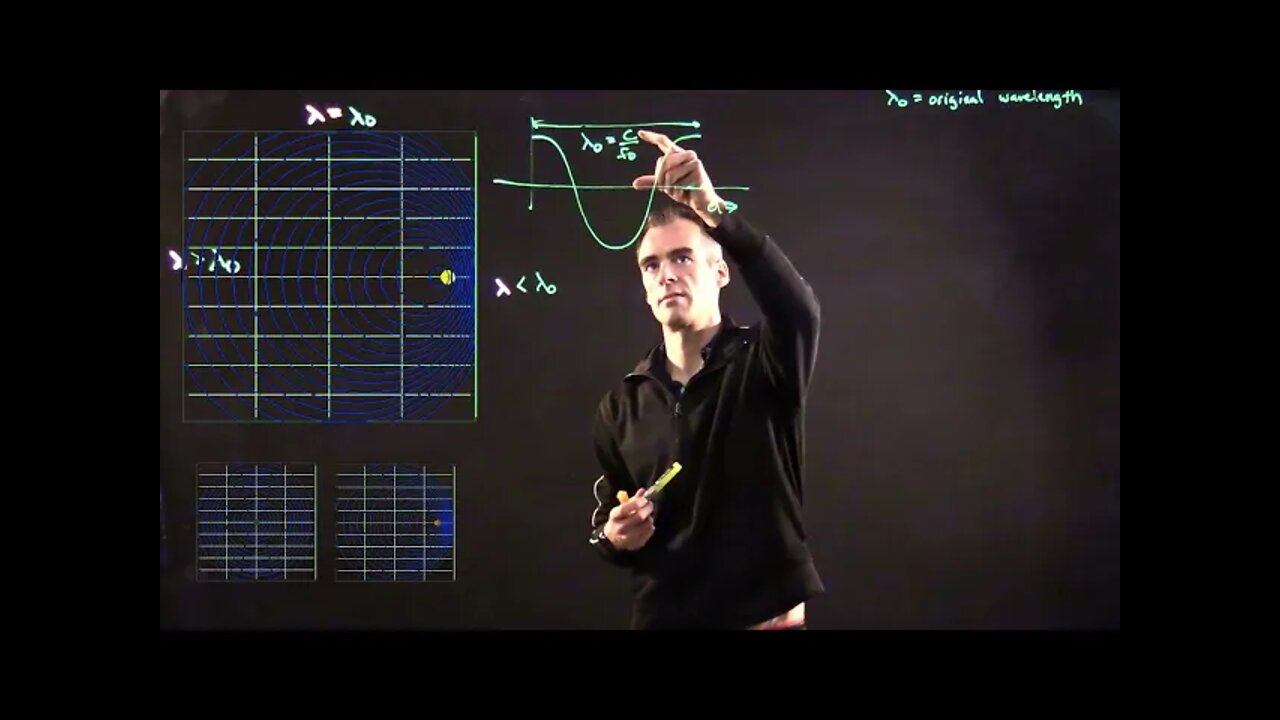Premium Only Content

Derivation of Doppler Equation for RADAR
This video shows how we get the Doppler Equation for RADAR to find the new wavelength, new frequency, or the speed of an object. Some animations are used to provide better intuition. Below is a basic script.
Let's consider how to tell what exactly these wavelength and frequency changes are
Let's look at the wavelength
So here is the propagation of a typical wave when the source is not moving
It's wavelength, lambda-not, is the distance it travels over one period
Now, let's say the source is moving, so that within the timeframe of this period, it moved up to this point
Now the wavelength is bunched in, so let's determine that new wavelength
It is the same as the old wavelength minus that distance it traveled
That distance it traveled is the velocity of the source times the period of time for the one oscillation we're considering
That period is simply one over the originial frequency, f_0, so let's replace that
And this is our equation for the new wavelength
We could also solve for the observed frequency, f, by subbing in here
Then taking the inverse of both sides, we can isolate the observed frequency by multiplying by c
Now this is a little tricky, but assuming the velocity is small compared to the speed of light, we can adjust this equation to make it easier as follows
And simplify with a 1 here.
So this would be the observed frequency given the source is traveling towards the observeer, which would be higher than the original frequency since we're adding, as expected
Consider though if were are looking at radar, we need to double this, because the radar wave goes to the object and back, so we get this effect twice
1 more thing to consider, and that is the angle.
We determined the equation for when the source is going straight towards the observer
But we allready noted this would have the opposite effect if the source was going away from the observer,
But also, what happens if the source is traveling perpendicular to the observer?
We can see that here that an observer on the top would observe the same frequency in either case. So there should be no 'Doppler shift' of the frequency for an observer here.
All we need to do to account for this is consider this angle, theta, and throw it into a cosine.
So checking this out,
if theta is 0, we do get larger f and lower wavelength
if theta is 90 degrees, that cosine term goes to 0, and we get no change.
If theta is 180 degrees, we get a negative value, corresponding to a smaller f and larger wavelength
So this checks out
Another way to consider this equation is if you always just consider theta as the angle between the objects velocity and the line between them, then you can consider this should be additive if they are going more toward each other, and negative if the velocity is taking the observer and source further away from each other.
And that is the basic intuition and a basic derivation of where we get the Radar Doppler Equation. Let me know if you have anything to add or any questions, and hopefully now you are properly inspired to dress up as the Doppler effect next Halloween.
Take care,
-
 DVR
DVR
Stephen Gardner
1 hour agoTrump's MOVE Ignites DEM Civil War - Top Leader on CHOPPING BLOCK!
8214 -
 DVR
DVR
The Tom Renz Show
1 hour agoObstructionist Judge Arrested & Is India the New China for Trade?
1691 -
 1:56:06
1:56:06
Steven Crowder
4 hours agoNY Times Goes Full Simp for Deported Jamaican Kidnapper
246K113 -
 LIVE
LIVE
Scammer Payback
1 hour agoCalling Scammers Live
276 watching -

The Big Mig™
1 hour agoGlobal Finance Forum From Bullion To Borders We Cover It All
9.75K10 -
 51:22
51:22
Steve-O's Wild Ride! Podcast
1 day ago $0.95 earnedAre The Trailer Park Boys Smarter Than They Seem? | Wild Ride 258
16K7 -
 1:58:10
1:58:10
The Charlie Kirk Show
2 hours agoArrested Judge + War On Harvard + AMA | Sen. Mullin, Rufo | 4.25.25
43.3K5 -
 LIVE
LIVE
IrishBreakdown
2 hours agoNotre Dame Football Mailbag
45 watching -
 51:11
51:11
The Rubin Report
3 hours agoGavin Newsom Torches the Democratic Party in a Shocking Interview
38.8K38 -
 5:24
5:24
Talk Nerdy Sports - The Ultimate Sports Betting Podcast
1 hour agoCold Data. Hot Bets. Riste’s Friday Warpath 🔪📈
6.38K